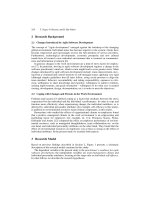PHP 5/MySQL Programming- P23 ppsx
Bạn đang xem bản rút gọn của tài liệu. Xem và tải ngay bản đầy đủ của tài liệu tại đây (123.67 KB, 5 trang )
Returning to the Petals Game
At the beginning of this chapter I show you the Petals Around the Rose game.
This game uses all the skills you have learned so far, including the new concepts
from this chapter. If you haven’t already done so, play the game now so you can
see how it works.
Here’s the basic plan of the
Petals game: Each time the page is drawn, it randomly
generates five dice and calculates the correct number of petals based on a super-
secret formula. The page includes a form that has a text area called
guess for the
user to enter the answer. The form also includes a hidden field called
numPetals,
which tells the program what the correct answer was.
The
Petals game doesn’t introduce anything new, but it’s a little longer than any
of the other programs you’ve seen so far. I introduce the code in smaller chunks.
All the code is shown in order, but not in one long code sample. Look on the CD
for the program in its entirety.
Starting HTML
Like most PHP programs, the Petals game uses some HTML to set everything up.
The HTML is pretty basic because PHP code creates most of the interesting HTML.
<HTML>
<head>
<title>Petals Around the Rose</title>
88
P
H
P
5
/M
y
S
Q
L
P
r
o
g
r
a
m
m
i
n
g
f
o
r
t
h
e
A
b
s
o
l
u
t
e
B
e
g
i
n
n
e
r
CAN’T THE PROGRAM REMEMBER THE RIGHT ANSWER?
Since the program generated the correct answer in the first place, you might be
surprised to learn that the right answer must be hidden in the Web page and
then retrieved by the same program that generated it. Each contact between
the client and the server is completely new.
When the user first plays the game, the page is sent to the browser and the con-
nection is completely severed until the user hits the submit button. When the
user submits the form, the Petals program starts over again. It’s possible the
user plays the game right before he goes to bed, then leaves the page on the
computer overnight. Meanwhile, a hundred other people might use the pro-
gram. For now, use hidden data to help keep track of the user’s situation. Later
in this book you learn some other clever methods for keeping track of the users’
situations.
</head>
<body bgcolor = “tan”>
<center>
<font face = “Comic Sans MS”>
<h1>Petals Around the Rose</h1>
I decided on a tan background with a whimsical font. This should give the program
a light feel.
Main Body Code
The main PHP code segment has three main jobs: print a greeting, print the dice,
and print the form for the next turn. These jobs are (appropriately enough)
stored in three different functions. One goal of encapsulation is to make the
main code body as clean as possible. This goal is achieved in the
Petals game.
<?
printGreeting();
printDice();
printForm();
All the real work is passed off to the various functions, which are described
shortly. Even before you see the functions themselves, you have a good idea what
each function does and a good sense of the program’s overall flow. Encapsulat-
ing your code and naming your functions well makes your code much easier to
read and repair.
The printGreeting() Function
The printGreeting() function prints one of three possible greetings to the user.
If the user has never called this program before, the program should provide a
welcome. If the user has been here before, she has guessed the number of petals.
That guess might be correct (in which case a congratulatory message is appro-
priate) or incorrect, requiring information about what the correct answer was.
The
printGreeting() function uses a switch statement to handle the various
options.
function printGreeting(){
global $guess, $numPetals;
if (empty($guess)){
print “<h3>Welcome to Petals Around the Rose</h3>”;
89
C
h
a
p
t
e
r
3
C
o
n
t
r
o
l
l
i
n
g
Y
o
u
r
C
o
d
e
w
i
t
h
C
o
n
d
i
t
i
o
n
s
a
n
d
F
u
n
c
t
i
o
n
s
} else if ($guess = = $numPetals){
print “<h3>You Got It!</h3>”;
} else {
print <<<HERE
<h3>from last try: </h3>
you guessed: $guess<br><br>
-and the correct answer was: $numPetals petals around the rose<br>
HERE;
} // end if
} // end printGreeting
This function refers to both the $guess and $numPetals variables, which are auto-
matically created. You can use one
global statement to make more than one vari-
able global by separating the variables with commas.
The
$guess variable is empty if this is the first time the user has come to the pro-
gram. If
$guess is empty, I print a welcoming greeting. The user has guessed cor-
rectly if
$guess is equal to $numPetals, so I print an appropriate congratulations. If
neither of these conditions is true (which is most of the time), the function prints
out a slightly more complex string indicating the user’s last guess and the correct
answer. This should give the user enough information to finally solve the riddle.
The
else if structure turns out to be the easiest option for handling the three
possible conditions I want to check.
The printDice() Function
After the program prints a greeting, it does the important business of generating
the random dice. It’s relatively easy to generate random dice, as you saw earlier
in this chapter. However, I also wanted to be efficient and calculate the correct
number of petals. To make the
printDice() function more efficient, it calls some
other custom functions.
function printDice(){
global $numPetals;
print “<h3>New Roll:</h3>”;
$numPetals = 0;
90
P
H
P
5
/M
y
S
Q
L
P
r
o
g
r
a
m
m
i
n
g
f
o
r
t
h
e
A
b
s
o
l
u
t
e
B
e
g
i
n
n
e
r
91
C
h
a
p
t
e
r
3
C
o
n
t
r
o
l
l
i
n
g
Y
o
u
r
C
o
d
e
w
i
t
h
C
o
n
d
i
t
i
o
n
s
a
n
d
F
u
n
c
t
i
o
n
s
$die1 = rand(1,6);
$die2 = rand(1,6);
$die3 = rand(1,6);
$die4 = rand(1,6);
$die5 = rand(1,6);
showDie($die1);
showDie($die2);
showDie($die3);
showDie($die4);
showDie($die5);
print “<br>”;
calcNumPetals($die1);
calcNumPetals($die2);
calcNumPetals($die3);
calcNumPetals($die4);
calcNumPetals($die5);
} // end printDice
The printDice() function is very concerned with the $numPetals variable, but
doesn’t need access to
$guess. It requests access to $numPetals from the main pro-
gram. After printing out the
“New Roll” message, it resets $numPetals to 0. The
value of
$numPetals is recalculated each time the dice are rolled.
I got new dice values by calling the
rand(1, 6) function six times. I stored each
result in a different variable, named
$die1 to $die6. To print out an appropriate
graphic for each die, I called the
showDie() function. I printed out a line break,
then called the
calcNumPetals() function once for each die.
The showDie() Function
The showDie() function is used to simplify repetitive code. It accepts a die value
as a parameter and generates the appropriate HTML code for drawing a die with
the corresponding number of dots.
function showDie($value){
print <<<HERE
<img src = “die$value.jpg”
height = 100
width = 100>
HERE;
} // end showDie
One advantage of using functions for repetitive HTML code is the ease with which
you can modify large sections of code. For example, if you wish to change image
sizes, change the img tag in this one function. All six die images are changed.
The calcNumPetals Function
The printDice() function also calls calcNumPetals() once for each die. This func-
tion receives a die value as a parameter. It also references the
$numPetals global
variable. The function uses a
switch statement to determine how much to add to
$numPetals based on the current die’s value.
Here’s the trick: The center dot of the die is the rose. Any dots around the center
dot are the petals. The value
1 has a rose but no petals; 2, 4, and 6 have petals, but
no rose;
3 has two petals; 5 has four. If the die roll is 3, $numPetals should be
increased by
2; if the roll is 5, $numPetals should be increased by 4.
function calcNumPetals($value){
global $numPetals;
switch ($value) {
case 3:
$numPetals + = 2;
break;
case 5:
$numPetals + = 4;
break;
} // end switch
} // end calcNumPetals
The +=code is a shorthand notation. The line shown here
$numPetals + = 2;
is exactly equivalent to this line:
$numPetals = $numPetals + 2;
TRICK
92
P
H
P
5
/M
y
S
Q
L
P
r
o
g
r
a
m
m
i
n
g
f
o
r
t
h
e
A
b
s
o
l
u
t
e
B
e
g
i
n
n
e
r









